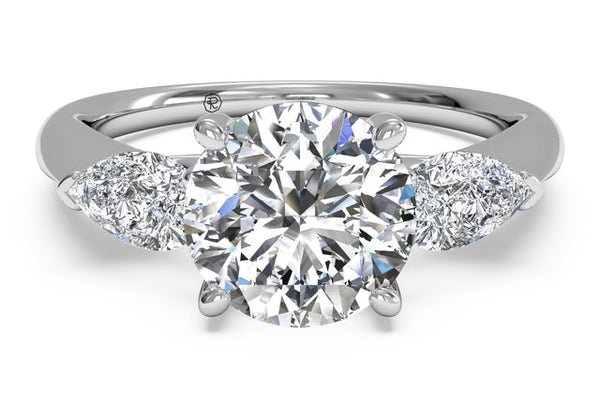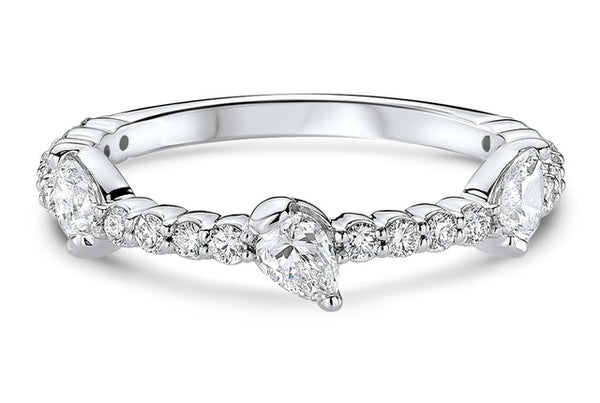How to Buy a Pear-Shaped Diamond

Pear-shaped diamonds have always been a unique and brilliant way to symbolize true love.
Hollywood actor Richard Burton once paid $1.1 million for a 69-carat, pear-shaped diamond cut by famous jeweler Harry Winston and presented it to his wife Elizabeth Taylor, the academy award-winning actress and fashion icon.
The incredible stone graced her neck in several public appearances and eventually became the centerpiece of a gorgeous Cartier ring. While their famously stormy relationship faded from the public eye many years ago, the Taylor Burton diamond made a permanent impression.

Image Source: Academy of Motion Picture Arts & Sciences, via VanityFair.com
While choosing an enormous, million-dollar diamond for Elizabeth Taylor may be a no-brainer, choosing a pear-shaped or teardrop diamond engagement ring for your fiancée takes confidence.
Why? Because the most common choice for diamond engagement rings is round-shaped diamonds. In fact, only 3-5% of Ritani diamond engagement rings feature pear-shaped center stones, making them a truly a unique and distinctive choice.
To take the guesswork out of choosing one of these unique stones, we’ve answered some of the most common questions diamond buyers ask about pear-shaped diamonds.
What is a pear shaped diamond?
A pear shaped diamond is also called a teardrop diamond because of its rounded shape which narrows into a point at the top or bottom. It is a modified brilliant round cut (which contains all 58 facets of a typical brilliant round diamond) on one end and the pointed tip (reminiscent of a marquise shape) on the other end.
Anatomy of a Pear Shaped Diamond
Pear-shaped diamonds have five parts or regions: The head, the shoulders, the belly, the wings, and the point. The head is round-shaped, like a brilliant round cut diamond. The shape begins to narrow below the shoulders toward the belly, before coming closer together at the wings and finally meeting in the dramatic point.

How do I choose a pear-shaped diamond?
There are several factors that affect the appearance and beauty of a pear-shaped diamond. These include proportion, symmetry, and shadows caused by the cut of the diamond.
The “Bow Tie Effect”
Bow ties belong on grooms and waiters, but not on your pear shaped diamond.
The “bow tie effect” on a pear shaped diamond is the light gray to black pattern resembling a bow tie that typically runs across the width of the stone from the center of the table. A cut that minimizes the effect to the point that it’s hardly visible is a key to a beautiful pear shaped diamond.

Source: GIA.edu
Proportion: Length to Width Ratio and Symmetry
Proportion can be one of the most important things to consider when buying a pear-shaped diamond. It is also the most subjective aspect and is really up to your individual taste.
In general, most people prefer a length to width ratio between 1.50 and 1.75. However, you need to decide what type of shape you prefer.
Do you like a stone with a flatter top or more rounded middle?
Look at a pear shaped diamond face up and check for gently rounded shoulders and wings. Wings that are too flat may make the diamond appear too narrow, while wings that are too rounded may make it look short and bulbous.
A beautiful pear shaped diamond must also have identical sides. To easily check the symmetry at a jeweler or online (using digital tools), draw a real or imagined line down the center, from the head to the point. The shoulder, belly, and wing portions should be identical, and 29 facets should be visible on both sides.
While the length-width ratio can give you a general idea of the shape, nothing beats seeing the diamond in person in order to determine the actual silhouette and other small details like eye cleanliness and bowtie effects. You can do so with no obligation to buy, with Ritani’s Free In-Store Preview program.
Are pear shaped diamonds cheaper than other diamonds?
One of the most appealing aspects of pear shaped diamonds are that they can be significantly less expensive than brilliant round shaped diamonds with the same cut, color, clarity, and carat weight attributes. This is because pear shaped diamonds usually have very minimal amount of waste when being cut from a raw stone.
Here’s a comparison of a few stones in Ritani’s current diamond inventory:
Shape | Carat Size | Cut Grade | Color | Clarity | Polish | Symmetry | Price |
|---|---|---|---|---|---|---|---|
Round | 1.00 | VG | F | VS1 | EX | VG | |
Pear | 1.00 | VG | F | VS1 | EX | VG | |
Round | 2.00 | VG | E | VS1 | EX | VG | |
Pear | 2.00 | VG | E | VS1 | EX | VG |
As carat size increases, the price gap between round and pear shaped diamonds widens. Reaching into the 3 carat range and higher ranges, pear shaped diamonds can add up to enormous savings.
How big is a 1-carat pear-shaped diamond?
Pear-shaped diamonds are longer than round diamonds of equal carat weights. A 1 carat pear-shaped diamond with a good length to width ratio measures about 8.57mm in length, whereas a 1 carat round shaped diamond measures only around 6.3mm. This can make the diamond appear larger.
From the head to the shoulder, pear-shaped diamonds are as round as round-shaped diamonds, but they become narrower at the belly, or roughly halfway down the surface before reaching the point.
Are pear-shaped diamonds popular?
At Ritani, pear-shaped diamonds account for 3-5% of weekly diamond sales. But the who’s who list of pear-shaped diamond engagement ring wearers is growing and includes Ariana Grande, Paris Hilton, Kaley Cuoco, Cardi B, Sophie Turner, Victoria Beckham, and Avril Lavigne.
How should you wear pear-shaped diamonds?
When worn as the center stone in an engagement ring, the round side or head of a pear shaped diamond typically faces the knuckle, while the point faces the fingernail. This makes the dramatic teardrop effect when the finger is raised. But the right look is different for different people. You may prefer to wear them the opposite way or even have your pear-shaped diamond set horizontally in a dramatic east-to-west orientation.
When worn vertically, a pear-shaped diamond engagement ring can make the wearer’s finger appear longer.
Pear-shaped diamonds are sometimes found as two side diamonds sitting on both sides of round diamonds in engagement rings, and as the main stones in necklaces and drop earrings.
As you can imagine, they can be worn in a number of different ways. Here are some of our favorite pieces of jewelry featuring pear-shaped diamonds:

A stunning engagement ring setting featuring pear-shaped side stones – $3,192

Elegant teardrop earrings with pear-shaped diamonds – $2500

Triple pear cut diamond stackable wedding ring – $2845
The Pear Shaped Diamond Engagement Ring for You
We invite you to explore our gorgeous selection of over 1,800 pear-shaped diamonds. If you find one you love, check out our engagement ring settings for pear-shaped stones.
You may want to stand out from the crowd, or you may simply love the pear shape. Whatever your desire, Ritani has a unique pear-shaped diamond engagement ring for you.
Learn more in our Ultimate Buying Guide and explore the 4 C's of Diamonds.


